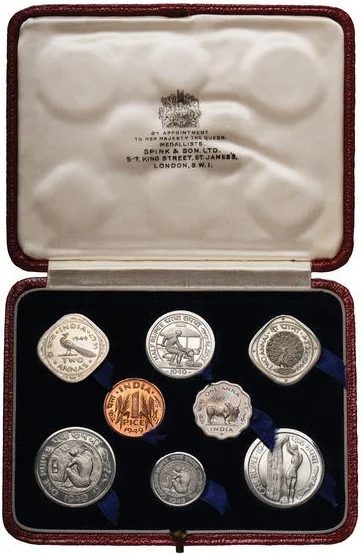1949 - Pattern Coins by Patrick Brindley
After the partition there was a need to introduce new coinage in India. In 1946, India saw the coinage in nickel which were been introduced the ½ and ¼ Rupee, as well 1 Rupee in 1947. The initial coinage of approximately 460 million pieces apparently sufficed until 1950 when new designs were introduced. No coins were stuck in the year 1948 and 1949.
In 1949 a fine pattern coinage was prepared by artist/engraver Patrick Brindley. It is not known whether final dies were actually prepared for these patterns, or whether the master matrices were used to strike the coins.
A highly important and exceedingly rare complete set of eight patterns. Only four sets are recorded as having been struck. All with matching proof-like surfaces, a few faint hairlines, but all brilliant mint state, in red leather Spink presentation case. Another set of these patterns was sold at Baldwin's Auction 71 in September 2011, lot 1609. This set however varies from the Baldwin's set as it contains two different examples of the rupee coin and one ½ rupee, while the Baldwin's set contained only one 1 rupee but two ½ rupees. No coins were struck for circulation dated 1948 or 1949. However, due to Partition and Independence, a distinct new series of designs were required. After Partition in July 1947 and the achievement of Independence by both India as well as the newly-created Pakistan, both countries thought to create new and distinctive coinages. During 1946 rupee coinage in nickel had been introduced in India, comprising the ½- and ¼ rupee struck in that year, followed in 1947 by a 1-rupee issue, with additional ½- and ¼ rupees of a similar design. The initial coinage of approximately 460 million pieces apparently sufficed until 1950 when new designs were introduced. However, in 1949 a fine pattern coinage was prepared by artist/engraver Patrick Brindley. It is not known whether final dies were actually prepared for these patterns, or whether the master matrices were used to strike the coins. For various reasons each of the 1949 patterns was rejected, leading to other designs introduced in the following year. The Spink Numismatic Circular of 1954 reports that only four sets of these patterns were struck. This set, housed in a Spink presentation case, was acquired from Spink at a later date - apparently the original price in 1954 was £100. It should be noted that it is uncertain whether the 'patterns' listed in Krause Mishler of ¼-, ½- and 1 rupee for 1947 are actually patterns, or whether at a later date the new Ashoka obverse proposed for the 1949 patterns was mated or perhaps muled with the currency 1947 reverse dies (60000-80000 GBP).












Comments
Post a Comment